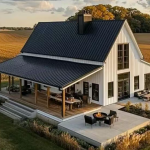Moblie: 8613816755915
Cost Analysis of Prefab houses in the United States
In recent years, U.S. real estate prices have remained stubbornly high. Traditional site-built homes have become prohibitively expensive due to rising construction costs, labor shortages, and capital’s relentless pursuit of high profits. Prospective homeowners have been forced to seek more affordable and efficient alternatives, making prefab houses increasingly popular. But what about the cost of prefab houses? We conducted a real financial analysis.
It is commonly believed that prefab houses are more cost-effective than traditional homes. However, it is important to note that the specific cost of a prefabricated home depends on several factors. These factors include:
- The number of stories in the prefabricated home you choose
- The complexity of the prefabricated home design
- The level of customization you desire for the prefabricated home
The Complete Cost Picture of Prefab houses
To avoid financial surprises, it is crucial to understand all the components that contribute to the final price of a move-in-ready modular home.
Modular home Itself
This is the price you pay the manufacturer for the module home designed, engineered, and constructed. It includes walls, floors, plumbing, electrical rough-in, cabinets, and fixtures. These costs do not cover appliances, decorative furnishings, or décor expens, which fall outside the scope of the structural modules and are considered custom homeowner additions.
Land and Site Work
This expense is essential beyond the modular home product itself and represents one of the most variable and frequently underestimated costs. You must purchase the land and budget for the following items:
- Land Purchase: Varies by municipality and location.
- Site Preparation: Clearance, grading, and ensuring utility access.
- Foundation: Similar to traditional construction, pouring a full basement, crawl space, or slab foundation represents a significant expense.
- Permits and Fees: Obtaining local building permits, environmental impact fees, and inspections are required, potentially costing thousands of dollars.
Delivery and Assembly
The modules must be transported from the factory to your site on specialized trucks and then carefully placed onto the foundation by a crane. This cost can range from $5,000 to $20,000+ depending on distance and complexity.
Finishing and Utility Hookup
Utility Connections: After module installation is complete, significant work remains. The general contractor must finalize connections to the public sewer/water lines and the power grid.
Taking all these factors into account, the average cost per square foot for prefab houses typically ranges from $80 to $120 per square foot (excluding land costs). If you’re looking for a prefabricated modular home, you’ll be pleased to know that the mid-range price for a spacious 1,800-square-foot residence falls between $144,000 and $216,000. Prefabricated prefab houses of 2,000 square feet or larger start at $160,000 and can reach $240,000 or more. Land costs, however, vary significantly by state.
Comparative Analysis: Prefab houses vs. Stick-Built homes
Consider a 2,000-square-foot home. The average cost to build a conventional home on-site may be $300,000, with a construction timeline of 12 months. In contrast, the total turnkey cost for a comparable modular home could be $250,000. Not only does this save $50,000, but the financing aspect is even more significant. Owners of prefab houses may only need to carry a construction loan for 6 months, saving thousands in interest expenses and enabling them to build equity faster.
Final Conclusion
The cost analysis of prefab houses reveals they are not merely a “cheap” alternative but a cutting-edge lifestyle choice. The initial savings per square foot in structural costs represent only the tip of the iceberg. Their true value lies in accelerated construction timelines, exceptional cost predictability, and the long-term benefits of energy efficiency and durable construction.

